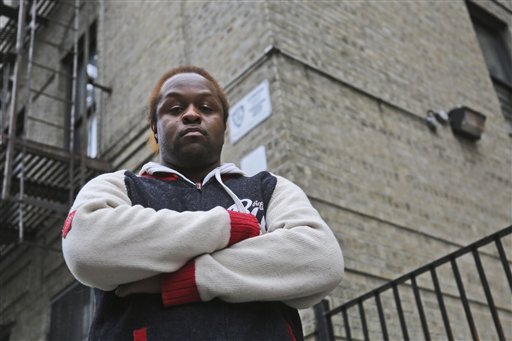By COLLEEN LONG
Associated Press
NEW YORK
Jay Victorino was standing outside his mother’s apartment when he was grabbed by police, and he says if she hadn’t come downstairs to identify him he would’ve been arrested on a trespassing charge.
That’s because his mother’s South Bronx building is one of thousands of private dwellings patrolled by the New York Police Department under a program known as Operation Clean Halls.
Victorino, 28, has mixed feelings about the program _ on one hand, he has seen his neighborhood become safer. On the other, he doesn’t think it’s right to be targeted.
His ambivalence was echoed by dozens of people around the city who live in buildings enrolled in the program, the only one of its kind in a major U.S. city that gives police standing permission to roam the halls of private buildings. Some residents say they feel safer, while others say they believe they are being harassed at home and, in some cases, illegally stopped and arrested. More than a dozen residents have filed a federal lawsuit saying their civil rights were violated.
Operation Clean Halls started in Manhattan in the 1990s, when crime was at an all-time high and some private building owners felt overwhelmed with wrongdoing inside their properties. Now, there are more than 3,000 participating buildings around the city, mostly in higher-crime areas such as the South Bronx. To enroll, a building owner or manager signs paperwork allowing police to enter and arrest people found to be committing crimes.
Edifices citywide are dotted with small white square signs alerting residents that their homes are patrolled by police. Some are huge complexes, others are small brownstones. Officers have conducted hundreds of thousands of patrols up and down stairwells and even more outside. They catch drug transactions, shoo away loiterers and break up fights, residents say.
But others say they can’t go home without being menaced. In August 2011, Ligon sent her teenage son to the corner store get ketchup for the fries she was making for dinner. He didn’t return.
Eventually, a police officer rang her doorbell and told her over the intercom to come down and identify her boy.
Ligon said her son later was arrested on a trespassing charge but the charge was dropped.
The lawsuit is one of three pending federal cases that involve the New York Police Department’s stop, question and frisk practice, championed by police Commissioner Raymond Kelly and Mayor Michael Bloomberg as a necessary crime-fighting measure that has helped the nation’s biggest city reach historically low crime rates in recent years. There were only 414 killings citywide last year, compared with 2,245 in 1990.
Kelly has called the practice a lifesaving tool that deters criminals from taking illegal weapons in public. Bloomberg invoked the toll of gun violence to defend the practice in his last State of the City address.
But with the steady uptick in the number of people stopped has come an increased chorus of complaints, including some from people who say they’ve been targeted because of their race. Last year, New York police stopped 533,042 people, more than five times the number in 2002. Fifty-five percent of those stopped were black, 32 percent were Hispanic and 10 percent were white. According to U.S. Census figures, there are 8.2 million people in the city: 26 percent are black, 28 percent are Hispanic and 44 percent are white.
The Clean Halls lawsuit was filed by the New York Civil Liberties Union and Bronx Defenders on behalf of Ligon and others who live in South Bronx apartment buildings enrolled in the program.
Another plaintiff, Abdullah Turner, who’s black, said he was waiting for a friend who was returning a sweater inside a Bronx building when an officer slapped his cellphone out of his hand and demanded to know what he was doing outside. Turner, 25, said he was arrested on a trespassing charge, which was dropped nearly six months later.
The trespass charge on which Turner was arrested is among the most common in the city. Last year there were about 8,700 arrests on it, and the year before there were more than 9,200. About a thousand of last year’s cases have been dismissed, and more than 2,100 from the year before were dismissed in some form, according to statistics from the state Division of Criminal Justice Services.
The lead attorney on the Clean Halls lawsuit, Alexis Karteron, said the “aggressive assault” on residents’ rights must be stopped.
U.S. District Court Judge Shira Scheindlin ruled this year that changes to the program must be made, but she reserved judgment on what those changes will be until the other stop and frisk cases are heard.
The second pending case deals with stops in public housing. The third, which challenges the practice in general, goes to trial this month.
Scheindlin said that police have systematically crossed the line when making trespass stops outside Clean Halls buildings.

COMMENTS
Please let us know if you're having issues with commenting.